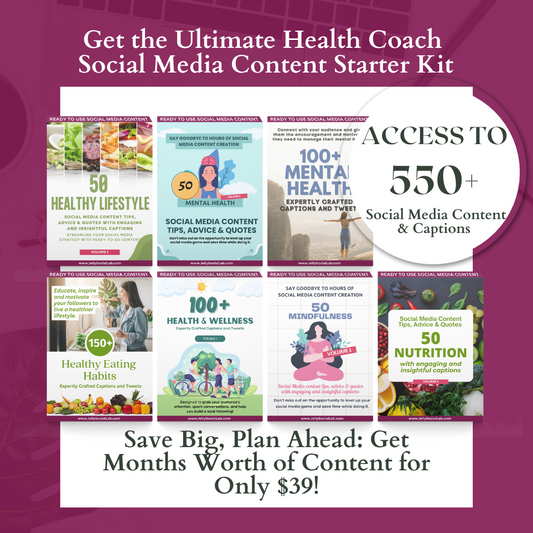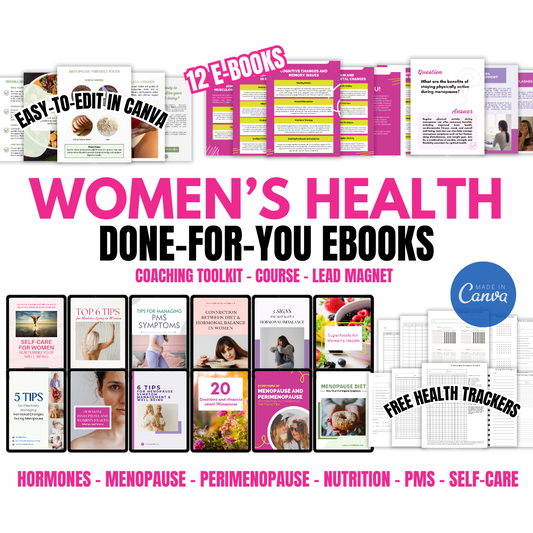
Why Your Wellness Business Isn't Getting Clients (+ Fixes)
Share
You're a talented wellness practitioner. Your clients get real results. You've invested thousands in certifications, training, and building your skills. So why isn't your wellness business schedule filling up the way you hoped?
If you're a health coach, yoga teacher, nutritionist, acupuncturist, or any other wellness professional struggling to attract consistent clients, you're not alone. The problem isn't your expertise—it's likely your marketing approach for your wellness business.
Let's talk about the most common marketing mistakes wellness practitioners make, and more importantly, how to fix them to grow your wellness practice.
The "Build It and They Will Come" Myth in Wellness Marketing
Many wellness practitioners and health coaches focus entirely on becoming better at their craft, assuming clients will naturally find them once they're skilled enough. But here's the hard truth: being excellent at what you do is only half the equation. If nobody knows your wellness business exists, your expertise doesn't matter.

Marketing for wellness professionals isn't about being pushy or salesy. It's simply about connecting the people who need your help with the transformation you offer. When you frame it that way, wellness business marketing becomes an extension of your mission to help others, not a necessary evil.
Mistake #1: Trying to Help Everyone (The Biggest Wellness Marketing Mistake)
When you try to appeal to everyone, you end up resonating with no one. "I help people with wellness" is too broad. Your ideal client needs to see themselves in your wellness business messaging immediately.
The Fix: Get specific about who you serve and what problem you solve.
Instead of "I'm a nutritionist who helps people eat better," try "I help exhausted working moms in their 40s lose weight without giving up the foods they love."
Notice the difference? The second version speaks directly to a specific person dealing with a specific struggle. That mom scrolling social media at 10 PM will stop and think, "Wait, that's me."
Your wellness business niche might feel limiting at first, but it's actually liberating. When you know exactly who you're talking to, creating content and marketing messages for your wellness practice becomes infinitely easier.
How to Find Your Wellness Business Niche
- Identify your ideal client's age, lifestyle, and main health challenges
- Analyze which clients you've helped achieve the best results
- Research what specific problems your target audience is searching for online
- Look at successful wellness practitioners in your field and how they position themselves
Mistake #2: Hiding Behind Your Credentials (Why Certifications Don't Sell Wellness Services)
Your certifications are important, but they're not what make someone book a consultation with your wellness practice. People don't buy credentials—they buy transformation and connection.
The Fix: Lead with the outcome, support with your credentials.
Your potential wellness client wants to know: Can you help me feel better? Have you helped people like me? Do I trust you?

Share your story. Talk about why you do this wellness work. Show before-and-after results (with permission). Let people see your personality. The wellness industry is deeply personal, and people work with health practitioners they feel connected to.
Your "About" page shouldn't read like a resume. It should tell the story of why you're passionate about wellness and how you're uniquely positioned to help your ideal client achieve their health goals.
Mistake #3: Inconsistent or Non-Existent Content (Killing Your Wellness Business Visibility)
Posting once a month when you remember, or only when you have a promotion, isn't a content strategy for wellness businesses. It's sporadic visibility that doesn't build trust or authority in the wellness industry.
The Fix: Show up consistently with valuable wellness content.
You don't need to be on every social media platform. Pick one or two where your ideal wellness clients hang out, and commit to a realistic posting schedule. Twice a week is infinitely better than daily posts for two weeks followed by radio silence.
Content Ideas That Work for Wellness Practitioners:
- Client success stories and testimonials (anonymized or with permission)
- Common wellness myths in your field debunked
- Simple health tips people can implement immediately
- Behind-the-scenes of your wellness practice
- Your perspective on trending wellness topics
- Quick educational posts about how the body and mind work
- Seasonal wellness tips and advice
- FAQ answers about your services
The goal of wellness content marketing isn't to give away everything for free—it's to demonstrate your expertise and build trust so when someone is ready to invest in their health, you're top of mind.
Best Social Media Platforms for Wellness Businesses:
- Instagram: Perfect for yoga teachers, fitness coaches, and holistic practitioners
- Facebook: Great for health coaches targeting 35+ demographics
- LinkedIn: Ideal for corporate wellness consultants and mental health professionals
- Pinterest: Excellent for nutritionists, meal planners, and recipe creators
- TikTok: Growing platform for younger wellness audiences and fitness content
Mistake #4: No Clear Path to Work With You (Losing Wellness Clients at the Finish Line)
Someone discovers your Instagram, loves your wellness content, and wants to work with you. But then what? They can't figure out what you offer, how it works, or how to get started. So they don't.
The Fix: Make it ridiculously easy for clients to take the next step.
Every piece of wellness content you create should have a clear call to action. Not always a hard sell, but a next step:
- Book a free discovery call or consultation
- Download your free wellness guide or ebook
- Join your email list for wellness tips
- Check out your services page
- DM you with questions about your wellness programs
- Schedule a free 15-minute strategy session
Your Wellness Business Website Must Answer These Questions Within Seconds:
- What wellness services do you provide?
- Who do you help? (your ideal client avatar)
- What health results can clients expect?
- How do you work together? (online, in-person, packages)
- What does it cost? (pricing transparency builds trust)
- How do I get started today?
If someone needs to click through five pages to understand your wellness offerings, you're losing potential clients. Make your wellness business website navigation simple and intuitive.
Mistake #5: Undervaluing Your Wellness Services (The Pricing Trap)
When you charge too little for your wellness services, you attract clients who don't value the work, you burn out trying to see enough clients to make a living, and ironically, you undermine your credibility. Higher prices often signal higher quality in the wellness industry.
The Fix: Price based on transformation, not time.
You're not selling an hour of your time as a wellness practitioner. You're selling the result—reduced pain, increased energy, better sleep, improved confidence, disease prevention, enhanced performance.
What's it worth to your client to finally solve the health problem they've been struggling with for years? That's your value. Price your wellness services accordingly, and don't apologize for it.
If someone balks at your wellness service prices, they're not your ideal client. The right people will see the value and invest in themselves.
How to Price Your Wellness Services:
- Calculate your desired annual income
- Determine how many clients you can realistically serve
- Research competitor pricing in your wellness niche
- Factor in your experience, certifications, and unique methodology
- Consider the lifetime value and transformation you provide
- Add premium pricing for specialized expertise
The One Marketing Strategy That Works for Every Wellness Business
If you implement nothing else from this wellness marketing guide, do this: start building an email list.

Social media platforms change their algorithms. Google changes SEO rules for wellness websites. But your email list? That's yours. It's the most direct line of communication with people who've already shown interest in your wellness services.
Offer something valuable in exchange for an email address—a free wellness guide, a mini-course, a 7-day challenge, a resource list. Then nurture that list with helpful content, stories, and occasional offers.
Email Marketing Benefits for Wellness Businesses:
- Email marketing has the highest ROI of any digital marketing channel
- Build deeper relationships with potential wellness clients
- Stay top-of-mind throughout their health journey
- Promote new wellness services and programs directly
- Share valuable content that establishes you as an authority
- Convert subscribers into paying clients on your schedule
For wellness practitioners, email marketing is especially powerful because health journeys take time, and staying in touch via email keeps you present throughout.
Free Lead Magnet Ideas for Wellness Businesses:
- "7-Day [Your Specialty] Challenge"
- "[Problem] Symptom Tracker Worksheet"
- "Ultimate Guide to [Health Topic]"
- "Healthy Meal Plan for Busy [Target Audience]"
- "[Your Niche] Wellness Checklist"
- "10 Signs You Need [Your Service]"
Growing Your Wellness Business: Your Marketing Mindset Shift
Marketing your wellness business doesn't have to feel icky or overwhelming. At its core, wellness marketing is simply communicating how you can help the people who need that help most.
Every person scrolling past your post or landing on your wellness website is potentially dealing with pain, confusion, or a health challenge you're trained to address. By showing up consistently, being clear about what you offer, and making it easy to work with you, you're doing them a service.
Your wellness business marketing doesn't need to be perfect. It needs to be present, authentic, and consistent.
Start with one marketing strategy from this list. Master it, then add another. Your future, fully booked wellness practice calendar will thank you.
Take Action: Your Wellness Business Marketing Checklist
Ready to transform your wellness business marketing? Here's your action plan:
✅ Define your specific wellness niche and ideal client
✅ Rewrite your About page to focus on transformation, not credentials
✅ Create a realistic content calendar (start with 2x per week)
✅ Simplify your website navigation and add clear CTAs
✅ Review and adjust your wellness service pricing
✅ Create a lead magnet and set up email marketing
✅ Schedule 30 minutes weekly to review your marketing metrics
Frequently Asked Questions About Wellness Business Marketing
How long does it take to see results from wellness business marketing?
Most wellness practitioners see initial results within 60-90 days of consistent marketing. Building a fully booked practice typically takes 6-12 months of strategic effort.
What's the best social media platform for health coaches?
Instagram and Facebook tend to perform best for most health coaches and wellness practitioners, but choose platforms where your ideal clients spend their time.
How much should I spend on marketing my wellness business?
Plan to invest 10-20% of your revenue back into marketing, including paid ads, tools, and content creation resources.
Do I really need a website for my wellness practice?
Yes. While social media is important, a professional wellness website establishes credibility and gives you control over your online presence.
How often should wellness practitioners post on social media?
Quality beats quantity. Aim for 2-4 valuable posts per week rather than daily low-quality content.
What's one marketing change you'll implement this week? The wellness world needs what you have to offer—don't keep it a secret.
P.S. If creating consistent content feels overwhelming, check out our done-for-you content templates at Wellness Content Kit—ready-made social posts, email templates, and lead magnets designed specifically for health and wellness businesses.
About Wellness Content Kit: We help wellness practitioners, health coaches, and holistic businesses create professional marketing content without the overwhelm. Get access to 3,400+ content prompts, done-for-you templates, and ready-to-post social media graphics.




